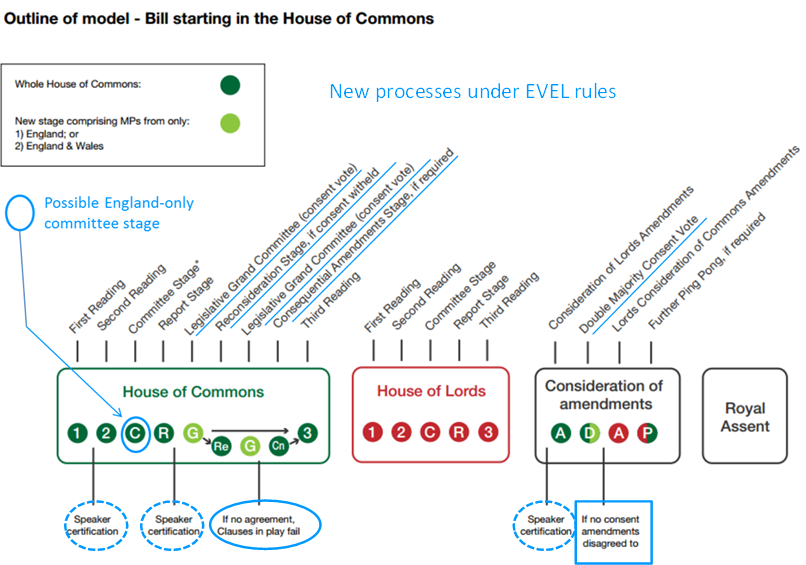
Diagram of the ‘English Votes for English Laws’ process, debated in the House of Commons in 2015 and referred to in the first quotation below
Information design researcher, Karel van der Waarde, whose work has influenced European legislation regarding the design of information communicated in patient information leaflets for packaged medicines, has recently carried out an informal search for references to information design in Hansard, the record of UK parliamentary proceedings. In the last seven years, the word ‘typography’ was not mentioned once. The word ‘diagram’ was mentioned 68 times, although in some cases less positively than others.
Here are some indicative examples.
“Has she had a chance to look at the diagram that the Leader of the House has so helpfully distributed? In box 3, in a circle that is half orange and half green, there is a letter P, which apparently refers to ‘Further Ping Pong, if required’.” Alex Salmond MP, July 2015
“There was a wonderful diagram of the interconnections between all the new bodies in the health service. It was like Spaghetti Junction.” Baroness Tonge, February 2012
“That is perhaps because it is quite easy to draw some sort of diagram—an organigram—on a page showing the relationships, but that is not necessarily what real life is like.” Baroness Hamwee, January 2017
“I cannot help thinking that if a diagram is needed to explain legislation, its supporters are in some sense doomed.” John Pugh MP, June 2012
The last quotation by John Pugh MP parallels a similarly disparaging comment in 1994 by Betty Boothroyd, the House of Commons Speaker, “I have always believed that all members of this house should be sufficiently articulate to express what they want to say without diagrams” (see post at Macro-typography). It does seem, however, that thinking is moving forward to alternative or complementary ways of presenting information where words alone are difficult to navigate. Karel notes that in many instances where the word ‘diagram’ is used, the speaker is asking for clarification, ‘maybe a diagram would be helpful’.

How far has information design infiltrated parliamentary discourse?
Diagram of the ‘English Votes for English Laws’ process, debated in the House of Commons in 2015 and referred to in the first quotation below
Information design researcher, Karel van der Waarde, whose work has influenced European legislation regarding the design of information communicated in patient information leaflets for packaged medicines, has recently carried out an informal search for references to information design in Hansard, the record of UK parliamentary proceedings. In the last seven years, the word ‘typography’ was not mentioned once. The word ‘diagram’ was mentioned 68 times, although in some cases less positively than others.
Here are some indicative examples.
“Has she had a chance to look at the diagram that the Leader of the House has so helpfully distributed? In box 3, in a circle that is half orange and half green, there is a letter P, which apparently refers to ‘Further Ping Pong, if required’.” Alex Salmond MP, July 2015
“There was a wonderful diagram of the interconnections between all the new bodies in the health service. It was like Spaghetti Junction.” Baroness Tonge, February 2012
“That is perhaps because it is quite easy to draw some sort of diagram—an organigram—on a page showing the relationships, but that is not necessarily what real life is like.” Baroness Hamwee, January 2017
“I cannot help thinking that if a diagram is needed to explain legislation, its supporters are in some sense doomed.” John Pugh MP, June 2012
The last quotation by John Pugh MP parallels a similarly disparaging comment in 1994 by Betty Boothroyd, the House of Commons Speaker, “I have always believed that all members of this house should be sufficiently articulate to express what they want to say without diagrams” (see post at Macro-typography). It does seem, however, that thinking is moving forward to alternative or complementary ways of presenting information where words alone are difficult to navigate. Karel notes that in many instances where the word ‘diagram’ is used, the speaker is asking for clarification, ‘maybe a diagram would be helpful’.
Share this: